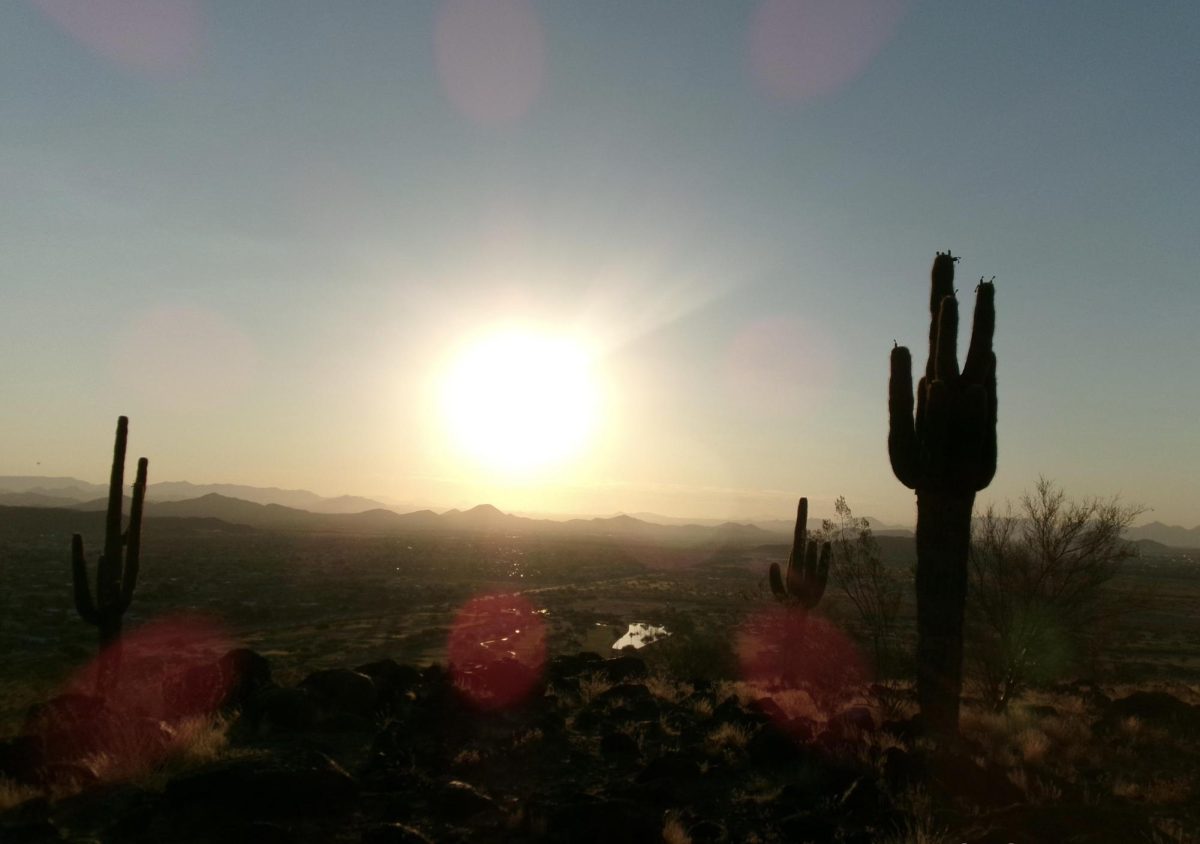This summer it was common to open the news, or front door, and discover that yet another heat record had been broken. The surge of heat, felt globally, continued to set previous temperature records up in flames during the months of June and July, and may continue throughout August and September. July, specifically, was the hottest month in NASA’s Goddard Institute for Space Studies record, which goes back to 1880. Global temperatures regularly peak in late July, but last month was 32.6°F/0.33°C warmer than the former record in 2019, an abnormal extremity.
Arizona experiences a regional temperature considerably hotter than the global average. July in Phoenix, paralleling the global records, was the hottest month ever documented in any U.S. city with an average temp. of 102.7°F/39.3°C. Thirty-one days were at, or above 110°F/43.3°C. To a certain extent, climate change is the culprit of this severity. However, there are additional factors at play.
“Trapped emissions and gasses are part of the equation, but here in the Valley, our urban heat island effect is to blame as well. What was once farmland or open desert is being replaced more and more by urban sprawl and concrete. This type of surface absorbs more heat and re-radiates it at night,” said April Warnecke, Good Morning Arizona meteorologist.
Urban designers and planners can reduce these effects by creating “cool islands” that utilize shade and vegetation in particular areas throughout the city. Nevertheless, as temperatures increase, so does air pressure, contributing to another cause of rising heat.
“An unrelenting ‘heat dome’ of high pressure that has trapped excessive heat over the desert southwest during the hottest part of the year has been the main factor. Our summer monsoon has been significantly reduced at this point by this ridge of high pressure that has not moved much at all for the past 30+ days,” said Sean McLaughlin, meteorologist for 3TV and CBS 5.
Multitudes of people are enduring the first hand consequences of the heat. It leaves locals wondering what future forecasts will look like.
“Some of the long-range forecast models point at increasing temperatures, and longer duration summers. It is hard to say exactly what will happen… Over the years Phoenix has seen more 100-degrees days. That impacts air condition bills, the amount of heat deaths/ER visits, and business productivity,” said Ian Schwartz, CBS 5 This Morning meteorologist.
This summer, the scorching sun was also paired with a lack of rain during the monsoon season. A common misconception is that increasing temperatures hindered rainfall. In actuality, the opposite is true.
“The heat wave did not impact the monsoon, but rather the other way around. The delayed onset of the monsoon led to hotter days without the typical cloud cover, higher humidity and rainfall we’d usually get this time of year,” Warnecke said.
The lack of seasonal storms does not indicate that Arizona will have more rain in the winter. The El Niño and La Niña climate patterns are better indicators of winter weather.
“We are in an El Niño year. Typically that means a wetter-than average winter. There’s no strong connection we’ve been able to determine between El Nino and the monsoon season. Right now, we are on track to have one of our driest monsoon seasons on record if we don’t get some impressive rain around here in the next few weeks,” Warnecke said.
Extreme heat also has the ability to exacerbate existing conditions, with drought and wildfires in particular.
“It can definitely pile on to our long-term drought situation. It can lead to more rapid evaporation from our lakes and reservoirs and can increase dramatically our risk for wildfires or to lengthen the wildfire season across the state and region,” McLaughlin said.
At OHS, athletics and activities that mainly take place outdoors, such as marching band and color guard, are some of the most vulnerable groups to be impacted by heat. The sports medicine program trains students to use heat safety guidelines, and allows experienced members to be on the field with sports teams.
“Every day before practice we take the heat index, which is the humidity combined with the temperature… Usually the caution is going to be approaching 100 degrees, extreme caution is going to be around 100 plus, and then danger is going to be the 110 and higher up,” said Cassandra Sahagun, sports medicine teacher.
High temperatures are an obstacle that OHS teams must adapt to. Fortunately, they are capable of sustaining greatness while adjusting practices.
“From [the heat index] we then follow a chart that tells us the modifications for practice. For sports that are outdoors like football it tells them gear wise that if it’s too hot maybe don’t use football pads or use helmets only. We will also decide to hold off practice for another 30 minutes or so, then they can watch film or run through plays indoors,” Sahagun said.
It can still be difficult to achieve heat acclimation. Safety is always the priority; first aid, nurses, and sports medicine students are ready to assist.
“We have seen heat related injuries in general. You can tell when they feel slowed down or they just look pale that they’re dehydrated. If they stop sweating it is kind of dangerous or if they’re not drinking enough water they could be throwing up and passing out,” said Sahagun.
The most important measures all OHS students should take is being knowledgeable about heat related issues so that they can prepare and protect themselves. It is as simple as not going outside for more than 30 minutes, or staying hydrated. Remaining calm is crucial.
“We take all precautions necessary to keep students safe such as designating certain areas in the school as ‘cool zones’ where students and staff can take breaks from the heat. All indoor facilities on campus are kept at a cool temperature. We also have access to water for every student,” said Justin McLain, assistant principal.



